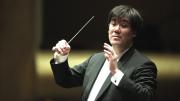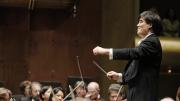Like his celebrated predecessor Leonard Bernstein ’39, D.Mus. ’67, Alan Gilbert ’89 seems to enjoy whipping up a whirlwind and then taking it for an exhilarating ride. Though only in his second year on the job, the second Harvard-educated music director of the New York Philharmonic has shaken things up at an orchestra that had grown a bit stodgy under previous conductors Kurt Masur and Lorin Maazel. Gilbert has freshened the repertory with new and unusual works by composers as diverse as György Ligeti and Wynton Marsalis, named a composer-in-residence (Magnus Lindberg), and started speaking informally to the audience, as Bernstein sometimes did. His programs are full of interconnections and his seasons add up; Gilbert has said that every piece tells a story, and every program should, too. His stated intention is “to play the widest range of orchestral repertoire as well as it can be played, while at the same time taking risks, striving to add to New York City’s artistic landscape in a way that places this orchestra squarely at the center of cultural and intellectual discourse.”
The Philharmonic sounds better than it has in decades, too, because Gilbert has improved morale, changed the seating plan, and worked on details of tone and balance—even the much-reviled acoustics of Avery Fisher Hall at Lincoln Center sound less jagged now. The conductor is also prepared to be surprised: to him, his job is both to lead and take in what the musicians are offering.
The unexpected hit of his first season was Ligeti’s avant-garde opera, Le Grand Macabre, in a staging by visual artist Doug Fitch ’81, a friend who had tutored art in Adams House when Gilbert was in college. To publicize the opera, Gilbert appeared in three homespun videos that the Philharmonic posted on YouTube; Death, a principal character in the opera, was his costar in all three. In one, Death sported a makeshift Halloween costume and ate an ice cream cone—“Pistachio,” he confided to Gilbert, who pointed out that Death had spilled some. In another, Gilbert and Death staged a musical duel using instruments from the popular music video game Guitar Hero. One can hardly imagine old-school maestros like Masur or Maazel doing such a thing (though Bernstein might have). In truth, Gilbert has been omnipresent in the media: he told the New York Times where he buys his bagels, and has begun writing “Curiously Random,” an entertaining and informative blog that appears irregularly at www.musicalamerica.com.
The young music director is a New York Philharmonic insider; both his parents played violin in the orchestra, and his mother, Yoko Takebe, still does (his father retired a few years ago). A child violinist, Gilbert studied music both at Juilliard in New York and Curtis in Philadelphia. At Juilliard, he had his first chance to conduct during a reading session of the first movement of Dvorák’s Sixth Symphony. “That was a crucial experience, a powerful experience, an eye-opening experience,” he says; Ronald Braunstein, the conductor of the pre-college orchestra, told him, “I think you have something.” Today, Gilbert is director of conducting and orchestral studies at Juilliard.
In college, Gilbert joined the Harvard-Radcliffe Orchestra and concentrated in music, even though “there were still people in the department who paradoxically believed that music should be seen and not heard,” he recalls. “I gravitated toward the faculty who were active in composition and performance—Earl Kim, Leon Kirchner, and Peter Lieberson.” As a senior, he conducted the Bach Society Orchestra. “The great thing about the Bach Society and about Harvard was that I had to create opportunities for myself; I got to do all kinds of things as a conductor and a performer that I would never have had the chance to do at Juilliard—not to mention coming up with plans, finding rehearsal space, arranging advertising and ticketing, and all the other administrative jobs that are involved beyond creating an artistic event. I emerged with a sense of ownership, and all that experience has stood me in very good stead.”
After graduation, Gilbert played violin as a substitute in the Philadelphia and Santa Fe orchestras and served as music director of the adventurous Haddonfield Symphony (now Symphony in C) in Camden, New Jersey, from 1992 to 1997. He was also assistant conductor at the Cleveland Orchestra and an active guest conductor in both the United States and Europe before taking the baton of the Royal Stockholm Philharmonic from 2000 to 2008—while working as well as music director of the Santa Fe Opera for three years, beginning in 2003.
His goal, says Gilbert, is to make a human and spiritual connection between the music and the audience “in a natural and handmade way that is also sophisticated and elegant. It is more important to make this kind of connection than to try to get everything right.” He adds, “The decisions I am making here at the Philharmonic, good or bad, are a function of being myself. When decisions are made by committee, you can feel it. It is possible to determine what people want and give it to them, but that is not the function of art, which is to lead. A great orchestra like the Philharmonic is a large operation, but you do not want people to think of it as impersonal. The responsibility of an American music director is to give the orchestra a face.”










